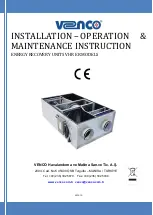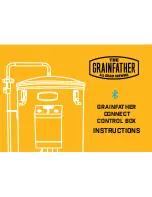
Fig.14- Abb.14
Fig.15 - Abb.15
Fig.16 Abb.16
Fig.17 - Abb.17
Fig.18 - Abb.18
Fig.19- Abb.19
È importante posizionare il veicolo sul sollevatore in modo che il
peso sia distribuito correttamente sui bracci (fig.14).Per la sicu-
rezza delle persone e dell'attrezzatura è importante che:
1.Le persone si mantengano all'interno dell'area di sicurezza
mentre il veicolo sta salendo (fig.12).
2.Il motore sia spento, la marcia sia inserita e il freno di stazionamen-
to sia tirato.
3.Il veicolo sia posizionato correttamente (Fig.14).
4.Vengono sollevati solo i veicoli autorizzati (fig.10-11) senza su-
perare la portata e le dimensioni idonee di sollevamento
Fig.14 Veicolo caricato correttamente
RISCHI DURANTE IL SOLLEVAMENTO DEL
VEICOLO
I seguenti dispositivi di sicurezza sono stati installati per proteg-
gere da condizioni di sovraccarico e guasti dell'apparecchiatura:
·
relè termico :scatta quando il motore è sovraccarico.
·
valvola di max pressione (fig.15)(posta sull'unità di potenza
idraulica):scatta quando il sollevatore è sovraccarico.
·
In caso di perdita importante e improvvisa nel circuito idraulico
(un tubo rotto), le valvole di bloccaggio, nella parte bassa di
ogni cilindro, scatteranno (fig.16).
·
Quando il sollevatore raggiunge l'altezza massima, un micro fa
fermare lo stesso (fig.17).
·
Tenere entrambi i cavi bilanciati durante il sollevamento o la
discesa. (Fig.18).
·
Se il cilindro idraulico si rompe, scatteranno i cunei di sicurez-
za (fig.19) che si trovano all'interno delle colonne. I cunei ven-
gono spinti dalla molla e fermano istantaneamente il carrello
impedendone la discesa.
·
In caso di rottura totale degli interruttori di finecorsa, il carrello
si fermerà alcuni mm più in alto, in quanto i cilindri idraulici ar-
rivando a finecorsa faranno scattare la valvola di pressione
massima (nell'unità idraulica)
·
Se il cavo non è bilanciato, entra in funzione il dispositivo con
cavo anti-cedimento (far riferimento alla fig.20). Accertarsi che
tale sistema funzioni correttamente (far riferimento alla fig.19).
It is important to position the vehicle on the lift so that the weight
is correctly distributed on the arms (Fig.14) for person and equip-
ment safety, it is important that:
1. People rest inside the safety area while the vehicle raising (Fig.12)
2. The engine is off, the clutch engaged and the parking brake pulled.
3. The vehicle is correctly positioned. (Fig.14).
4. Only authorized vehicle (Fig.10-11) are raised without exceeding
the rate capacity and overall dimensions.
RISKS WHILE THE VEHICLE IS BEING RAISED
The following safety devices have been installed to protect aga-
inst overweight conditions and equipment failure:
·
The thermal relay in the electric box will trip if the motor is overloa-
ded.
·
The maximum pressure valve (Fig.15), located on the hydrau-
lic oil power unit, will trip if the lift is overloaded.
·
In case of a sudden, great leakage in the hydraulic circuit (a
broken pipe), the blocking valves, at the bottom of each Cylin-
der, will trip (Fig.16).
·
If the lift reaches to the maximum height, push the button to
stop it(Fig.17).
·
Keep both cables in balance during raising or lowering. (Fig.18).
·
If the hydraulic cylinder breaks, the safety wedges will trip (Fig.19),
located inside the posts. The wedges are pushed by the spring and
immediately stop the carriage preventing their descent.
·
If the moving part exceed its travel distance, on the upper part
of the command post there is a limit switches connected in se-
ries and are usually set working by the “actuator”(Fig.17) on
the command side carriage. If the first limit switch did not work,
the second one would trip after 3sec of carriage run.
·
In case of total breakdown of the limit swatches, the carriage will
stop a few mm higher, because the hydraulic cylinders come to
end stroke, will cause the maximum pressure valve (on hydraulic
unit) to trip.
·
If the cable is not balance, the rope anti-loosen device function (re-
fer Fig.20). Make sure that this system works well (refer Fig.19).
25
Summary of Contents for 209I/A
Page 2: ......
Page 61: ......
Page 62: ...STRUTTURA PRINCICPALE 380 MAIN STRUCTURE 380V...
Page 63: ...COLONNA COMANDO 380 MAIN COLUMN 380V...
Page 64: ...QUADRO ELETTRICO TRIFASE 380V THREE PHASE CONTROL PANEL 380V...
Page 65: ...CENTRALINA OLEODINAMICA 380V OLEODYNAMIC CONTROL UNIT 380V...
Page 66: ...STRUTTURA PRINCICPALE 220 MAIN STRUCTURE 220V...
Page 67: ...COLONNA COMANDO 220 MAIN COLUMN 220V...
Page 68: ...QUADRO ELETTRICO MONOFASE 220V MONO PHASE CONTROL PANEL 220V...
Page 69: ...CENTRALINA OLEODINAMICA 220V OLEODYNAMIC CONTROL UNIT 220V...
Page 70: ...TRAVERSA CROSSBEAM...
Page 71: ...CILINDRO CYLINDER...
Page 72: ...CARRELLO PRINCIPALE MAIN CARRIAGE...
Page 73: ...CARRELLO SECONDARIO SUB CARRIAGE...
Page 74: ...BRACCIO LUNGO LONG ARM BRACCIO CORTO SHORT ARM...
Page 75: ...BLOCCAGGIO BRACCI ARM LOCKING DEVICE...
Page 76: ...COLONNA SERVIZIO SUB COLUMN...
















































